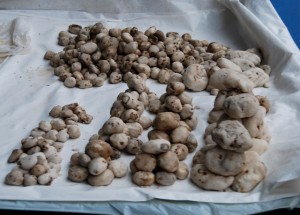A Very Ancient and Very Contemporary Soup, Chuño Cola
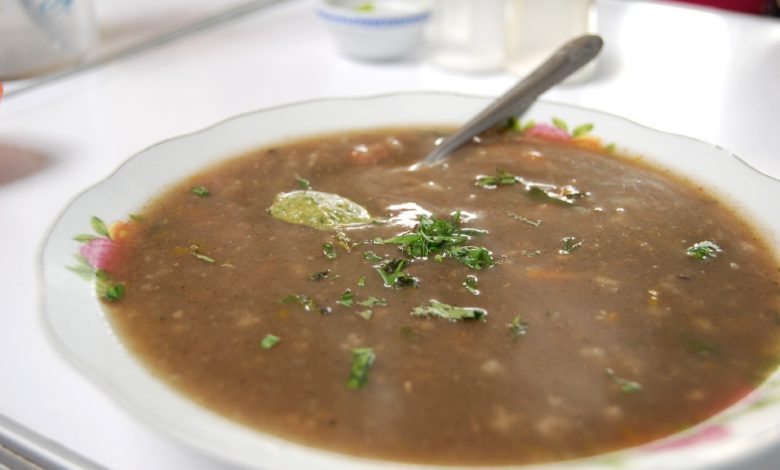
Though summer in Cuzco, it may as well be winter, since people tend to stay indoors during the cold afternoons when it rains. When it is chilly like this people look for something hot. What is better for lunch or diner than a delicious hot soup such as chuño cola (lagua,) as its called in Quechua, a purée of traditional freeze dried potatoes, that draws one in with its taste and texture.
In the popular markets of Cuzco, such as San Pedro, San Blas, Wanchaq, and Ttio, this creme is always present since a large part of the population takes refuge there from the cold and rain while seeking hot food.
When you walk among the food stalls the caseras (vendors) call out, giving you a warm welcome. With a smile they invite you to try a hot and creamy chuño cola soup.
It is traditional to accompany it with beef, jerky, and some uchukuta (hot sauce). Together they make us forget a hard day’s work in these days of cold and heavy rain that our city lives.
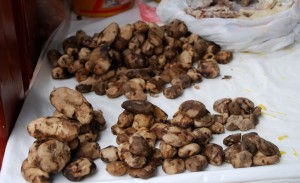
Not only does this creme bring us together, it makes us wonder at how potatoes become chuño. Harvested potatoes are laid out in a single layer on straw to suffer the nighttime frosts in June and July. In the day they thaw and people come to step on them and squeeze all the liquid from them. After repeating this process over several days the potatoes remain as dried and hard black lumps able to be stored for an indeterminate amount of time. In Quechua the word chuño means wrinkled, referring to the resultant texture of the dried potatoes. When soaked and reconstituted, then cooked, they arrive on the table to bring nourishment.

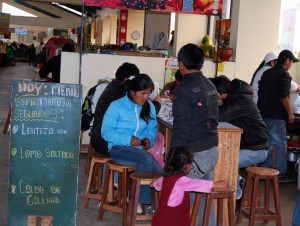
This ancient technique of preserving potatoes for much longer than the undried potato would last is surprising because many months can pass, even years if one were to wish, and yet the potato is still consumable. There are different ways of making chuño which are practiced in rural areas mostly outside the city. The manner in which the potato is dehydrated in order to convert it into chuño is as follows.
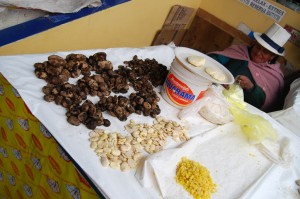
First the potatoes are sorted. generally smaller potatoes are chosen to make chuño in the quantity desired. Then people wait for the coldest months, when there is a hard frost in the higher altitudes. , such as June and July. At that time, if left out overnight the potatoes will freeze solid, but the days have to thaw and get warm.
Then, on a clean flat meadow or piece of land, the potatoes are laid one in a single layer. They are left out all night. In the morning, at dawn, they are placed into mounds so they can be stepped on and the water squeezed from them. This is done before the sun comes out so they won’t turn black.
Then they are put in a spring or pool of hard water (aqnu yaku) for 8 to 14 days, After this to one of sweet water for about a month. When the chuño is ready it will float to the surface of the water.
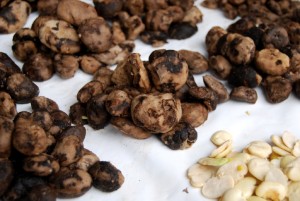
Finally, it is laid out on dried ichu grass for seven or more days until the sun and air have dried it.
This traditional means of making chuño, often called moraya in Peru or tunta in Bolivia as a grayish white chuño to distinguish it from the stronger flavored black product just called chuño in both countries.
This traditional form of making chuño dates from well before the Incas. It is very ancient and chuño is found in very old archeological excavations. We inherited this technique and continue practicing it as a wise means of conserving food for today’s population.
These days of rain and cold is when one should seize the moment and eat chuño, especially ground and in soup. Chuño makes its way into a range of dishes, but there is none better than the delicious creme called chuño cola.
